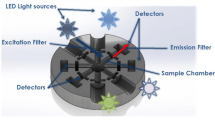Abstract
Purpose. The weak aqueous interaction between the protein lactate dehydrogenase (LDH) and the nonionic surfactant Tween 80 has been investigated, because weak protein-amphiphile interactions are of significant importance in pharmaceutical formulations, but are experimentally hard to determine. The system LDH/sodium dodecyl sulphate (SDS) was used as reference because SDS, by its strong protein binding, denatures LDH completely.
Methods. Fluorescence spectroscopy with pyrene and 1,3-bis(1-phenyl)propane (P3P) as probes, intrinsic protein fluorescence and NMR spectroscopy have been used.
Results. The fluorescence probe pyrene monitors a weak Tween-LDH interaction, detectable below the critical micelle concentration of ordinary Tween micelles. The microviscosity probe P3P shows a surfactant-induced denaturation in the case of LDH/SDS but not in the case of LDH/Tween 80. Intrinsic LDH fluorescence verifies this behavior. Pulsed-gradient spin-echo NMR was also used to verify the weak LDH-Tween 80 interaction.
Conclusions. A weak interaction between LDH and Tween 80 occurs at hydrophobic zones of the protein, but it is not strong enough to denature LDH. The experimental outline used here provides a useful approach for mapping the very weak protein-amphiphile interactions often present in pharmaceutical formulations.
Similar content being viewed by others
REFERENCES
J. F. Carpenter and J. H. Crowe. The mechanism of cryoprotection of proteins by solutes. Cryobiology 25:244–255 (1988).
B. S. Chang, B. S. Kendrick, and J. F. Carpenter. Surface-induced denaturation of proteins during freezing and its inhibition by surfactants. J. Pharm. Sci. 85:1325–1330 (1996).
L. Kreilgaard, L. S. Jones, T. W. Randolph, S. Frokjaer, J. M. Flink, M. C. Manning, and J. F. Carpenter. Effect of Tween 20 on freeze-thawing-and agitation-induced aggregation of recombinant human factor XIII. J. Pharm. Sci. 87:1597–1603 (1998).
W. Wang. Instability, stablilization, and formulation of liquid protein pharmaceuticals. Int. J. Pharm. 185:129–188 (1999).
E. D. Goddard and K. P. Ananthapadmanabhan. Interactions of surfactants with polymers and proteins, CRC Press, Inc, Boca Raton, Florida, 1993.
T. Arakawa, Y. Kita, and J. F. Carpenter. Protein-solvent interactions in pharmaceutical formulations. Pharm. Res. 8:285–291 (1991).
M. J. Adams, G. C. Ford, R. Koekoek, P. J. Lentz, A. McPherson, M. G. Rossmann, I. E. Smiley, R. W. Schevitz, and A. J. Wonacott. Strucutre of lactate dehydrogenase at 2.8 Å resolution. Nature 227:1098–1103 (1970).
S. Nema and K. E. Avis. Freeze-thaw studies of a model protein, lactate dehydrogenase, in the presence of cryoprotectants. J. Parent. Sci. Technol. 47:76–83 (1993).
N. J. Turro, X.-G. Lei, K. P. Ananthapadmanabhan, and M. Aronson. Spectroscopic probe analysis of protein-surfactant interactions: The BSA/SDS system. Langmuir. 11:2525–2533 (1995).
M. Vasilescu, D. Angelescu, M. Almgren, and A. Valstar. Interactions of globular proteins with surfactants studied with fluorescence probe methods. Langmuir. 15:2635–2643 (1999).
K. Kalyanasundaram and J. K. Thomas. Environmental effects on vibronic band intensities in pyrene monomer fluorescence and their applications in studies on micellar systems. J. Am. Chem. Soc. 99:2039–2044 (1977).
K. A. Zachariasse. Intramolecular eximer formation with diarkylalkanes as a microfluidity probe for sodium dodecyl sulphate micelles. Chem. Phys. Lett. 57:429–432 (1978).
P. Stilbs. Fourier transform pulsed-gradient spin-echo studies of molecular diffusion. Prog. Nucl. Magn. Reson. Spectrosc. 19:1–45 (1987).
J. E. Tanner. Use of the stimulated echo in NMR diffusion studies. J. Chem. Phys. 52:2523–2526 (1970).
P. Stilbs, K. Paulsen, and P. C. Griffiths. Global least-squares analysis of large, correlated spectral data sets: Application to component resolved FT-PGSE NMR spectroscopy. J. Phys. Chem. A. 100:8180–8189 (1996).
H. Evertsson, S. Nilsson, C. Holmberg, and L.-O. Sundelöf. Temperature effects on the interactions between EHEC and SDS in dilute aqueous solutions. Steady-state fluorescence quenching and equilibrium dialysis investigations. Langmuir. 12:5781–5789 (1996).
L. S. C. Wan and P. F. S. Lee. CMC of polysorbates. J. Pharm. Sci. 63:136–137 (1974).
J. R. Lakowicz. Principles of Fluorescence Spectroscopy, Second Edition, Kluwer Academic Plenum Publishers, New York, 1999.
R. Zana. Microviscosity of aqueous surfactant micesses: Effect of various parameters. J. Chem. Phys. B. 103:9117–9125 (1999).
H. Evertsson and S. Nilsson. Microviscosity in EHEC/SDSclusters formed in dilute aqueous solutions as determined with fluorescence probe techniques. Macromolecules 30:2377–2385 (1997).
U. Sivars and F. Tjerneld. Mechanisms of phase behavior and protein partitioning in detergent/polymer aqueous two-phase systems for purification of integral membrane proteins. Biochem. Biophys. Acta 1474:133–146 (2000).
N. B. Bam, J. L. Cleland, J. Yang, M. C. Manning, J. F. Carpenter, R. F. Kelley, and T. W. Randolph. Tween protects recombinant human growth hormone against agitation-induced damage via hydrophobic interactions. J. Pharm. Sci. 87:1554–1559 (1998).
Author information
Authors and Affiliations
Corresponding author
Rights and permissions
About this article
Cite this article
Hillgren, A., Evertsson, H. & Aldén, M. Interaction Between Lactate Dehydrogenase and Tween 80 in Aqueous Solution. Pharm Res 19, 504–510 (2002). https://doi.org/10.1023/A:1015156031381
Issue Date:
DOI: https://doi.org/10.1023/A:1015156031381




